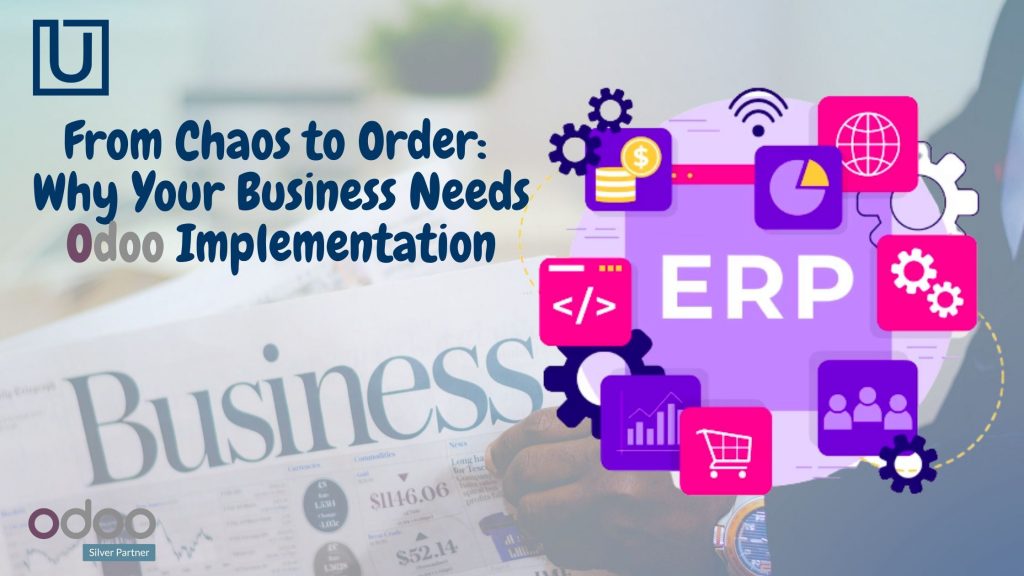In today’s fast-paced business world, efficiency and organization are key to success. As businesses grow and expand, managing multiple processes and departments can quickly become overwhelming. Enter Odoo, the all-in-one business management software that promises to transform chaos into order. With its comprehensive suite of integrated applications, Odoo streamlines and automates various business functions, from sales and marketing to inventory management and accounting. But why should your business invest in Odoo implementation? The answer lies in the power of efficiency. By centralizing all of your business processes into one platform, Odoo eliminates the need for multiple disparate systems, reducing complexity and improving productivity. With customizable modules and seamless integration, Odoo empowers businesses of all sizes to optimize their operations, boost collaboration, and ultimately drive growth. So, if you’re ready to take your business from chaos to order, it’s time to embrace the power of Odoo and unlock a new level of efficiency and success.
Understanding the Chaos in Business Processes
Running a business involves handling numerous processes and departments simultaneously. From sales and marketing to HR and finance, each aspect of your business has its own set of tasks and requirements. Without a centralized system in place, these processes can quickly become chaotic and difficult to manage.
For example, your sales team may be using one software for customer relationship management, while your finance team uses a separate system for accounting. This lack of integration can lead to data discrepancies, duplicated efforts, and a significant waste of time and resources.
With Odoo implementation, you can bring order to this chaos. By consolidating all your business processes into a single platform, Odoo ensures that information flows seamlessly between departments, eliminating silos and enabling better collaboration. With a unified view of your business operations, you can make informed decisions, identify bottlenecks, and streamline workflows.
Benefits of Odoo Implementation
Implementing Odoo offers a wide range of benefits for businesses looking to optimize their operations and drive growth. Let’s explore some of the key advantages of embracing Odoo:
- Streamlined Operations
One of the primary advantages of Odoo implementation is the streamlining of business operations. With Odoo’s integrated suite of applications, you can automate and consolidate various processes, eliminating the need for manual data entry and reducing the risk of errors. From lead management and sales tracking to inventory management and invoicing, Odoo provides a centralized platform to manage all aspects of your business.
- Improved Collaboration
Collaboration is key to success in today’s business landscape. With Odoo, you can foster better collaboration among your teams by providing them with a unified platform to share information, documents, and ideas. Whether it’s sharing customer data with the sales team or collaborating on projects with the marketing team, Odoo’s integrated approach promotes seamless communication and collaboration, leading to increased efficiency and productivity.
- Enhanced Data Visibility and Reporting
In order to make informed decisions, businesses need access to accurate and up-to-date data. Odoo offers robust reporting and analytics capabilities, providing real-time insights into your business performance. With customizable dashboards and reports, you can monitor key metrics, track progress, and identify areas for improvement. This data-driven approach enables you to make data-backed decisions and drive your business forward.
- Scalability and Flexibility
As your business grows, so do your requirements. Odoo is designed to scale with your business, allowing you to add or modify modules as needed. Whether you need additional features for inventory management or want to integrate a new CRM system, Odoo’s modular structure makes it easy to adapt and customize the platform to meet your evolving needs. This scalability and flexibility ensure that Odoo remains a valuable asset to your business in the long run.
- Cost and Time Savings
Investing in multiple software systems can be costly and time-consuming. With Odoo, you can consolidate your software expenses into a single platform, reducing licensing and maintenance costs. Additionally, implementing Odoo saves time by eliminating the need for manual data entry and reducing the risk of errors. By automating and streamlining processes, Odoo frees up valuable time for your employees to focus on high-value tasks, ultimately improving productivity and driving profitability.
Odoo Implementation Statistics
Before diving into the implementation process, let’s take a look at some statistics that highlight the success and popularity of Odoo:
- According to a study conducted by Odoo, businesses that implemented Odoo experienced an average increase in productivity of 30%.
- A survey of Odoo users found that 95% of respondents reported increased efficiency after implementing Odoo.
- Odoo has over 5 million users worldwide, making it one of the most widely used business management software solutions.
- The Odoo community consists of over 20,000 active members, continuously contributing to the development and improvement of the platform.
These statistics demonstrate the positive impact Odoo implementation can have on businesses, reinforcing its reputation as a reliable and effective solution.
Planning for Odoo Implementation
Before embarking on the Odoo implementation journey, it’s essential to have a well-thought-out plan in place. Here are some key considerations to keep in mind:
- Define Your Objectives
Clearly define your objectives for implementing Odoo. Identify the pain points and challenges you hope to address, whether it’s improving sales processes, streamlining inventory management, or enhancing collaboration. Setting clear goals will help guide the implementation process and ensure that Odoo aligns with your business needs.
- Assess Your Current Processes
Conduct a thorough assessment of your existing processes and systems to identify areas that need improvement. Map out your current workflows, document existing processes, and identify any bottlenecks or inefficiencies. This analysis will help you understand how Odoo can fit into your existing infrastructure and optimize your operations.
- Involve Key Stakeholders
Involving key stakeholders from different departments is crucial for a successful Odoo implementation. Engage representatives from each team to gather their input, address their concerns, and ensure their buy-in. This collaborative approach will help foster a sense of ownership and increase the chances of a smooth transition.
- Allocate Resources
Odoo implementation requires dedicated resources, both in terms of time and personnel. Identify the team members who will be responsible for overseeing the implementation process and allocate sufficient time and resources for training and support. Adequate resource allocation is vital to ensure a seamless and successful implementation.
- Consider Customization and Integration
Odoo offers a wide range of modules and features to cater to various business needs. Evaluate the modules that are essential for your business and determine if any customization is required. Additionally, consider the integration of Odoo with your existing systems, such as CRM or e-commerce platforms, to ensure a seamless flow of data across systems.
By carefully planning and considering these factors, you can set the stage for a successful Odoo implementation that aligns with your business goals and requirements.
Key Considerations for a Successful Odoo Implementation
Implementing Odoo requires careful planning and execution. Here are some key considerations to keep in mind to ensure a successful implementation:
- Set Realistic Expectations
It’s important to set realistic expectations for the implementation process. Odoo is a comprehensive business management software with various modules and features, and implementing all of them at once may not be feasible. Prioritize your requirements and focus on implementing the most critical modules first. This phased approach will help manage expectations and ensure a smoother transition.
- Conduct Thorough Testing
Before going live with Odoo, conduct thorough testing to identify and resolve any issues or bugs. Test different scenarios, involve end-users in the testing process, and gather feedback to ensure that the system meets their requirements. This rigorous testing will help minimize disruptions and ensure a smooth transition to Odoo.
- Provide Training and Support
Training plays a critical role in the successful adoption of Odoo. Provide comprehensive training to your employees to familiarize them with the new system and its functionalities. Offer ongoing support and resources to address any questions or concerns that may arise during the implementation process. By investing in training and support, you can ensure that your employees are equipped to make the most of Odoo’s capabilities.
- Communicate and Manage Change
Change management is essential when implementing a new system like Odoo. Communicate the benefits of Odoo to your employees and involve them in the decision-making process. Address any concerns or resistance to change and provide regular updates on the implementation progress. By actively managing change and involving your employees, you can foster a positive attitude towards Odoo and increase user adoption.
Steps Involved in Odoo Implementation
The implementation process may vary depending on the size and complexity of your business. However, here are the general steps involved in an Odoo implementation:
- **Requirements Gathering**: Identify and document your business requirements and objectives for Odoo implementation.
- **System Configuration**: Configure Odoo to align with your business needs, including setting up modules, workflows, and user permissions.
- **Data Migration**: Migrate your existing data from legacy systems to Odoo. Clean and validate the data to ensure accuracy.
- **Customization**: Customize Odoo to meet your specific business requirements, such as creating custom fields, reports, or dashboards.
- **Testing**: Conduct rigorous testing to ensure that Odoo functions as expected and meets your business requirements.
- **Training**: Provide comprehensive training to your employees on how to use Odoo effectively.
- **Go-Live**: Deploy Odoo in a live environment and transition from your legacy systems to Odoo.
- **Post-Implementation Support**: Offer ongoing support and address any issues or questions that arise after the go-live.
By following these steps and adapting them to your business needs, you can successfully implement Odoo and unlock its full potential.
Common Challenges and How to Overcome Them
While Odoo implementation offers numerous benefits, it’s important to be aware of potential challenges that may arise. Here are some common challenges and strategies to overcome them:
- Resistance to Change
Resistance to change is a common challenge when implementing any new system. To overcome this, communicate the benefits of Odoo to your employees, involve them in the decision-making process, and address any concerns or resistance early on. Providing comprehensive training and ongoing support will also help employees adapt to the new system more smoothly.
- Data Migration Issues
Data migration can be complex and time-consuming. To overcome data migration issues, thoroughly clean and validate your data before migrating it to Odoo. Identify any data mapping or transformation requirements and involve experts if needed. Testing the migrated data before going live will help identify and resolve any issues.
- Lack of User Adoption
User adoption is crucial for the success of any system implementation. To encourage user adoption, provide comprehensive training, offer ongoing support, and highlight the benefits of using Odoo. Involve end-users in the planning and decision-making process, and address any usability concerns or feedback they may have.
- Customization Challenges
Customizing Odoo to meet your specific business requirements may pose challenges. To overcome customization challenges, clearly define your customization needs and involve experts or developers if necessary. Prioritize your customization requirements and focus on the most critical ones first. Regularly test and validate the customizations to ensure they align with your business goals.
By proactively addressing these challenges and leveraging the support of experts if needed, you can ensure a successful Odoo implementation and maximize the benefits for your business.
Conclusion: Embracing Order with Odoo
In a rapidly evolving business landscape, managing multiple processes and departments can quickly become overwhelming. However, with the power of Odoo implementation, you can transform chaos into order. By centralizing all your business processes into one platform, Odoo streamlines operations, enhances collaboration, and provides valuable insights into your business performance. With its scalability, flexibility, and cost-saving benefits, Odoo empowers businesses to optimize their operations and drive growth.
From streamlining sales and inventory management to enhancing collaboration and project management, Odoo offers a comprehensive solution to businesses of all sizes and industries. So, if you’re ready to take your business from chaos to order, embrace the power of Odoo and unlock a new level of efficiency and success.
By implementing Odoo, your business can transition from chaos to order, streamlining operations, improving collaboration, and optimizing processes. With the benefits of Odoo implementation, including enhanced data visibility, scalability, and cost savings, your business can thrive in today’s competitive landscape. By following key considerations and overcoming common challenges, you can successfully implement Odoo and unlock its full potential. So, embrace the power of Odoo and take your business to new heights of efficiency and success.
























